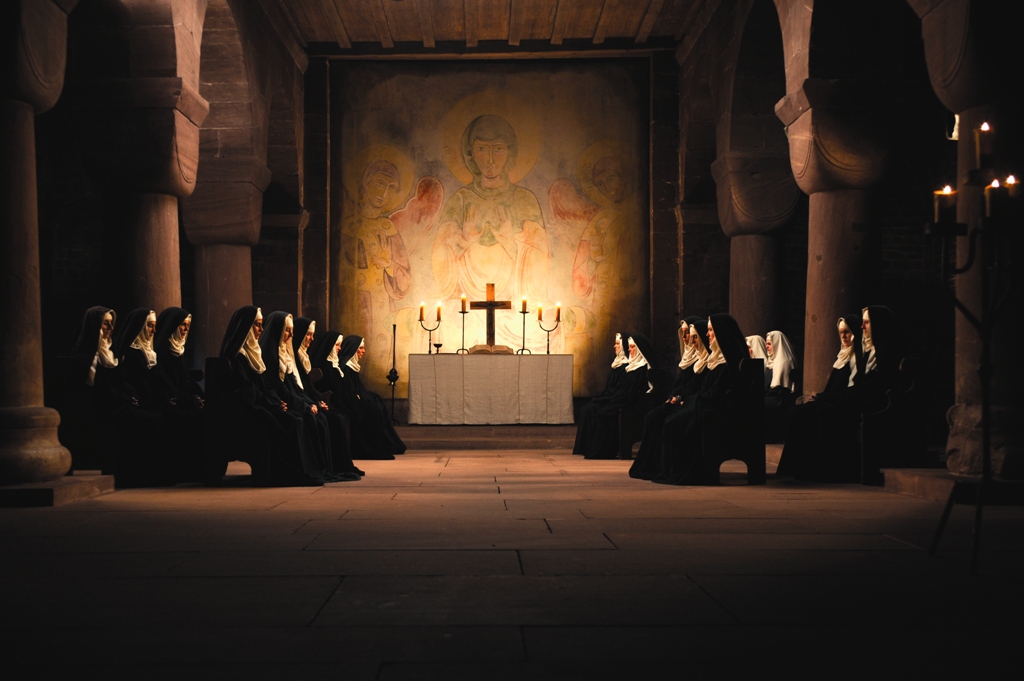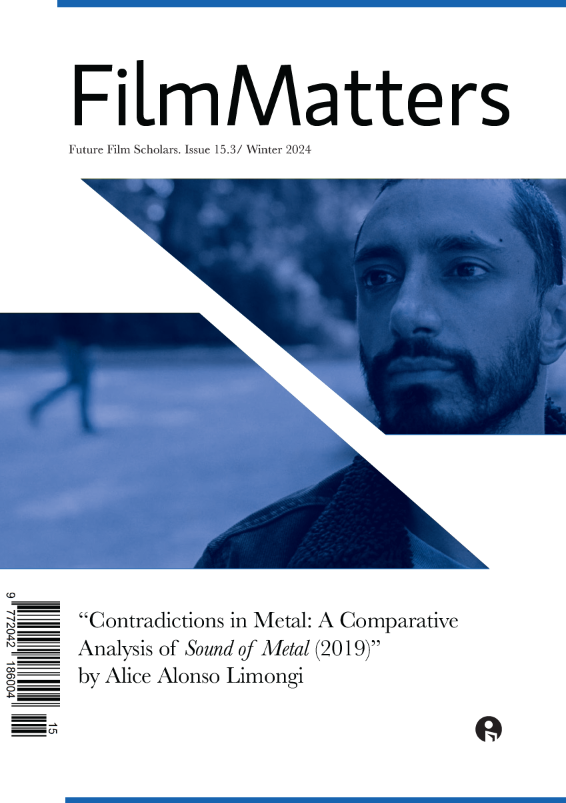Jacob Mertens received an Honorable Mention in the Vision Frame Analysis Contest 2011.

Mankind loves the illusion of order. For instance, we can take an abstract idea like rain falling from the sky and ascribe relentless categorization. In our capable hands, rain transmutes into weather, condensation, water molecules, and hydrogen and oxygen; but as the substance moves into microscopic specificity, it loses its inherent essence. Classification does little to describe the feeling of falling to sleep as rain pelts the roof or even the smell of water on grass. We live in a world full of phenomena that we barely understand and yet we refuse to accept a loss of full control. To me, this is what the frame taken from Visions: From the Life of Hildegard von Bingen embodies. The cast of light barely reaching the foreground of the frame, the failed symmetry of the mise-en-scene, and the colorful clothing of the sainted juxtaposed with the nunnery habits all reinforce the notion of structure vying to exist in an environment of sublime beauty and doubt. The frame itself lives within an existential threshold of revelation, and our measured gaze challenges whether the world was meant to be rigid or mutable.
Our contention with the order of the frame begins with light. The stone that surrounds the women, and holds the frame together, receives its form from several candles. Immediately, we see that the hardened stone cannot exist in our perception of the frame without its wavering and transient source of illumination. In other words, since cinema is a representational medium, the ground gains life by our awareness of its image. The framing plays on that knowledge. It places the light at the far depth of the screen, allowing the foreground to skulk into darkness. As we study the ground, we see a squared and structural floor design vanish at the edge of the image, as if epitomizing the liminal aspect of our spiritual awareness. Consequently, if the frame resonates in a moment of spiritual meditation, as seems likely, our visual understanding of that moment includes a lack of complete clarity of the environment. Meanwhile, the women cast long shadows as they pray, emphasizing that even as they bask in the light that kindles an evocative religious tapestry, they remain the causal agents of obfuscation. Ultimately, the light transcends its rigid surroundings, embodying warmth and inspiration, calling forth memories of nostalgia and grace from the audience. The women, however, cannot see it, their eyes closed in prayer.
At first glance, the frame feels symmetrical as well, as if the act of prayer should adhere to a stringent aesthetic configuration. The frame upsets this balance though, by placing a candle on the right edge of the foreground. After viewers absorb the incandescent tapestry flanked by women on both sides, their gaze lists to the right, pulled from a centralized viewing orientation. This simple framing decision keeps the cross in the middle of the frame from gaining too much prominence, from subsuming each individual prayer as a brooding meditation on the death of Christ. Instead, the room itself embraces the women’s invocation, allowing each benediction to become individualized and without forced meaning. In other words, by subverting the frame’s symmetry, viewers themselves can ascribe meaning to each unspoken prayer. In this way, the narrative action gains spontaneity and independence from an otherwise orthodoxical purpose, solely motivated by how one sees the frame.
Finally, the clothing design of the women’s habits represents an iconographic association with religion, based on the forfeiture of free will. The women have assumed the plain robes that have robbed them of their identity, and, try as viewers might, they will find it an impossible task to distinguish one woman from another. The nuns have become a collective presence in the sight of god, their common submission unifying in the somber act of prayer. And yet, the religious tapestry that looms over them depicts vibrant and colorful robes, as well as distinct halos of light. In religious tradition, saints are allowed their own story, seeking god on their own terms. And yet, the women have abandoned their intrepid path to God, favoring the ease of routine and the definitive knowledge offered by tradition. The formless cloaks envelop them, and the only women who bare a slight deviation in their dress, white hoods instead of black, are staged in the back right corner. Again, the frame establishes an aberration in the order of its staging almost subliminally, purposefully dismantling its inherent perfection.
The most fascinating aspect of the frame is that even in a seemingly inhospitable environment, all stone and mortar, viewers can feel the presence of God. It could be argued though, that religious meaning was never meant to be constructed or defined. Instead, at its most poignant, one’s connection with the divine remains inscrutable. Despite the obvious staging of the women around a holy glow of light, they cannot see the glory. They can only hear their fellow neighbor breathing next to them, can only feel the warmth of the room. Despite their need for order, with their eyes closed they are left with words and feeling alone. However, in terms of how to approach the ethereal, this is as good a place to start as any.
Author Biography
Jacob Mertens is an undergraduate Film Studies major at the University of North Carolina Wilmington. His work has been published in Film Matters, Atlantis, and also Film International, for which he currently writes. He received honorable mention for the Frank Capra Award for Excellence in Undergraduate Film Criticism and has presented at several academic conferences, most recently seen at the PCA/ACA conference for his paper “Videogames as Art: Dismantling the External Protagonist.” After graduating, Jacob plans to get his MFA in screenwriting.







































